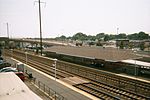Ballistic Research Laboratory
Harford County, MarylandResearch installations of the United States Army
The Ballistic Research Laboratory (BRL) was a leading U.S. Army research establishment situated at Aberdeen Proving Ground, Maryland that specialized in ballistics (interior, exterior, and terminal) as well as vulnerability and lethality analysis. BRL served as a major Army center for research and development in technologies related to weapon phenomena, armor, electronic devices, and high-speed computing. In 1992, BRL was disestablished and its mission, personnel, and facilities were incorporated into the newly created Army Research Laboratory (ARL).BRL is perhaps best known for commissioning the creation of ENIAC, the first electronic general-purpose digital computer.
Excerpt from the Wikipedia article Ballistic Research Laboratory (License: CC BY-SA 3.0, Authors).Ballistic Research Laboratory
Hopkins Run,
Geographical coordinates (GPS) Address Nearby Places Show on map
Geographical coordinates (GPS)
| Latitude | Longitude |
|---|---|
| N 39.475555555556 ° | E -76.111388888889 ° |
Address
Hopkins Run 2
21005
Maryland, United States
Open on Google Maps








